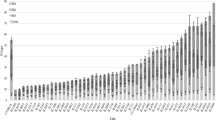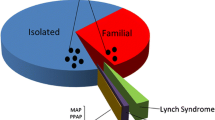Abstract
Germline mutations in the adenomatous polyposis coli (APC) gene cause familial adenomatous polyposis (FAP), a hereditary colon cancer syndrome in which affected individuals may develop 100–1000s of colonic adenomas. In families affected by FAP, adenoma number can vary markedly between individuals, despite the fact that these individuals carry the same APC mutation. In at least some FAP pedigrees, evidence suggests that these phenotypic differences are caused by segregating modifier alleles that impact adenoma number. However, identifying these modifiers in the human population is difficult, therefore mouse models are essential. Using the Apc Min/+ mouse colon cancer model, we previously mapped one such modifier, Mom5, to a 25 Mbp region of chromosome 5 that contains hundreds of genes. The purpose of the present study was to refine the Mom5 interval and evaluate candidate genes for the Mom5 modifier of intestinal neoplasia. Recombinant mice were used to narrow the Mom5 interval to 8.1 Mbp containing 70 genes. In silico and gene expression analyses were utilized to identify and evaluate potential candidate genes that reside within this interval. These analyses identified seven genes within the Mom5 interval that contain variants between the B6 and 129P2 strains. These genes represent the most likely candidates for the Mom5 modifier.




Similar content being viewed by others
References
Aitman TJ, Glazier AM, Wallace CA, Cooper LD, Norsworthy PJ, Wahid FN, Al-Majali KM, Trembling PM, Mann CJ, Shoulders CC, Graf D, St Lezin E, Kurtz TW, Kren V, Pravenec M, Ibrahimi A, Abumrad NA, Stanton LW, Scott J (1999) Identification of Cd36 (Fat) as an insulin-resistance gene causing defective fatty acid and glucose metabolism in hypertensive rats. Nat Genet 21:76–83
Aoki K, Taketo MM (2007) Adenomatous polyposis coli (APC): a multi-functional tumor suppressor gene. J Cell Sci 120:3327–3335
Baran AA, Silverman KA, Zeskand J, Koratkar R, Palmer A, McCullen K, Curran WJ Jr, Edmonston TB, Siracusa LD, Buchberg AM (2007) The modifier of Min 2 (Mom2) locus: embryonic lethality of a mutation in the Atp5a1 gene suggests a novel mechanism of polyp suppression. Genome Res 17:566–576
Casbas-Hernandez P, D’Arcy M, Roman-Perez E, Brauer HA, McNaughton K, Miller SM, Chhetri RK, Oldenburg AL, Fleming JM, Amos KD, Makowski L, Troester MA (2013) Role of HGF in epithelial-stromal cell interactions during progression from benign breast disease to ductal carcinoma in situ. Breast Cancer Res 15:R82
Chen P, Mo Q, Wang B, Weng D, Wu P, Chen G (2012) Breast cancer associated fibroblasts promote MCF-7 invasion in vitro by secretion of HGF. J Huazhong Univ Sci Technol 32:92–96
Chiba S, Tsuchiya N, Horikawa Y, Narita S, Inoue T, Akihama S, Saito M, Numakura K, Tsuruta H, Huang M, Satoh S, Habuchi T (2014) Functional mononucleotide repeat polymorphism in the promoter region of HGF is associated with risk and malignant aggressiveness of bladder cancer. Int J Oncol 44:678–684
Cho S, Park EM, Febbraio M, Anrather J, Park L, Racchumi G, Silverstein RL, Iadecola C (2005) The class B scavenger receptor CD36 mediates free radical production and tissue injury in cerebral ischemia. J Neurosci 25:2504–2512
Coolidge CJ, Seely RJ, Patton JG (1997) Functional analysis of the polypyrimidine tract in pre-mRNA splicing. Nucleic Acids Res 25:888–896
Cormier RT, Hong KH, Halberg RB, Hawkins TL, Richardson P, Mulherkar R, Dove WF, Lander ES (1997) Secretory phospholipase Pla2g2a confers resistance to intestinal tumorigenesis. Nat Genet 17:88–91
Crabtree MD, Tomlinson IP, Hodgson SV, Neale K, Phillips RK, Houlston RS (2002) Explaining variation in familial adenomatous polyposis: relationship between genotype and phenotype and evidence for modifier genes. Gut 51:420–423
Crabtree MD, Fletcher C, Churchman M, Hodgson SV, Neale K, Phillips RK, Tomlinson IP (2004) Analysis of candidate modifier loci for the severity of colonic familial adenomatous polyposis, with evidence for the importance of the N-acetyl transferases. Gut 53:271–276
Crist RC, Roth JJ, Lisanti MP, Siracusa LD, Buchberg AM (2011) Identification of Mom12 and Mom13, two novel modifier loci of Apc (Min)-mediated intestinal tumorigenesis. Cell Cycle 10:1092–1099
Debinski HS, Love S, Spigelman AD, Phillips RK (1996) Colorectal polyp counts and cancer risk in familial adenomatous polyposis. Gastroenterology 110:1028–1030
DeFilippis RA, Chang H, Dumont N, Rabban JT, Chen YY, Fontenay GV, Berman HK, Gauthier ML, Zhao J, Hu D, Marx JJ, Tjoe JA, Ziv E, Febbraio M, Kerlikowske K, Parvin B, Tlsty TD (2012) CD36 repression activates a multicellular stromal program shared by high mammographic density and tumor tissues. Cancer Discov 2:826–839
Dietrich W, Katz H, Lincoln SE, Shin HS, Friedman J, Dracopoli NC, Lander ES (1992) A genetic map of the mouse suitable for typing intraspecific crosses. Genetics 131:423–447
Dietrich WF, Lander ES, Smith JS, Moser AR, Gould KA, Luongo C, Borenstein N, Dove W (1993) Genetic identification of Mom-1, a major modifier locus affecting Min-induced intestinal neoplasia in the mouse. Cell 75:631–639
Febbraio M, Abumrad NA, Hajjar DP, Sharma K, Cheng W, Pearce SF, Silverstein RL (1999) A null mutation in murine CD36 reveals an important role in fatty acid and lipoprotein metabolism. J Biol Chem 274:19055–19062
Giardiello FM, Krush AJ, Petersen GM, Booker SV, Kerr M, Tong LL, Hamilton SR (1994) Phenotypic variability of familial adenomatous polyposis in 11 unrelated families with identical APC gene mutation. Gastroenterology 106:1542–1547
Groden J, Thliveris A, Samowitz W, Carlson M, Gelbert L, Albertsen H, Joslyn G, Stevens J, Spirio L, Robertson M (1991) Identification and characterization of the familial adenomatous polyposis coli gene. Cell 66:589–600
Guo YF, Wang XB, Tian XY, Li Y, Li B, Huang Q, Zhang M, Li Z (2012) Tumor-derived hepatocyte growth factor is associated with poor prognosis of patients with glioma and influences the chemosensitivity of glioma cell line to cisplatin in vitro. World J Surg Oncol 10:128
Kammula US, Kuntz EJ, Francone TD, Zeng Z, Shia J, Landmann RG, Paty PB, Weiser MR (2007) Molecular co-expression of the c-Met oncogene and hepatocyte growth factor in primary colon cancer predicts tumor stage and clinical outcome. Cancer Lett 248:219–228
Keller KL, Liang LC, Sakimura J, May D, van Belle C, Breen C, Driggin E, Tepper BJ, Lanzano PC, Deng L, Chung WK (2012) Common variants in the CD36 gene are associated with oral fat perception, fat preferences, and obesity in African Americans. Obesity 20:1066–1073
Koch M, Hussein F, Woeste A, Grundker C, Frontzek K, Emons G, Hawighorst T (2011) CD36-mediated activation of endothelial cell apoptosis by an N-terminal recombinant fragment of thrombospondin-2 inhibits breast cancer growth and metastasis in vivo. Breast Cancer Res Treat 128:337–346
Kuriki K, Hamajima N, Chiba H, Kanemitsu Y, Hirai T, Kato T, Saito T, Matsuo K, Koike K, Tokudome S, Tajima K (2005) Increased risk of colorectal cancer due to interactions between meat consumption and the CD36 gene A52C polymorphism among Japanese. Nutr Cancer 51:170–177
Martin-Fuentes P, Civeira F, Recalde D, Garcia-Otin AL, Jarauta E, Marzo I, Cenarro A (2007) Individual variation of scavenger receptor expression in human macrophages with oxidized low-density lipoprotein is associated with a differential inflammatory response. J Immunol 179:3242–3248
Miyoshi Y, Ando H, Nagase H, Nishisho I, Horii A, Miki Y, Mori T, Utsunomiya J, Baba S, Petersen G (1992) Germ-line mutations of the APC gene in 53 familial adenomatous polyposis patients. Proc Natl Acad Sci USA 89:4452–4456
Moser AR, Pitot HC, Dove WF (1990) A dominant mutation that predisposes to multiple intestinal neoplasia in the mouse. Science 247:322–324
Moser AR, Dove WF, Roth KA, Gordon JI (1992) The Min (multiple intestinal neoplasia) mutation: its effect on gut epithelial cell differentiation and interaction with a modifier system. J Cell Biol 116:1517–1526
Nnadi SC, Watson R, Innocent J, Gonye GE, Buchberg AM, Siracusa LD (2012) Identification of five novel modifier loci of Apc(Min) harbored in the BXH14 recombinant inbred strain. Carcinogenesis 33:1589–1597
Oikarinen SI, Cleveland AG, Cork KM, Bynote KK, Rafter JJ, Gustafsson JA, Mutanen M, Gould KA (2009) Genetic mapping of Mom5, a novel modifier of Apc(Min)-induced intestinal tumorigenesis. Carcinogenesis 30:1591–1596
Paul P, Letteboer T, Gelbert L, Groden J, White R, Coppes MJ (1993) Identical APC exon 15 mutations result in a variable phenotype in familial adenomatous polyposis. Hum Mol Genet 2:925–931
Reed R (1989) The organization of 3′ splice-site sequences in mammalian introns. Genes Dev 3:2113
Roche JK (2001) Isolation of a purified epithelial cell population from human colon. Methods Mol Med 50:15–20
Roscigno RF, Weiner M, Garcia-Blanco MA (1993) A mutational analysis of the polypyrimidine tract of introns. Effects of sequence differences in pyrimidine tracts on splicing. J Biol Chem 268:11222–11229
Rozen P, Samuel Z, Shomrat R, Legum C (1999) Notable intrafamilial phenotypic variability in a kindred with familial adenomatous polyposis and an APC mutation in exon 9. Gut 45:829–833
Schneikert J, Behrens J (2007) The canonical Wnt signalling pathway and its APC partner in colon cancer development. Gut 56:417–425
Scott RJ, van der Luijt R, Spycher M, Mary JL, Muller A, Hoppeler T, Haner M, Muller H, Martinoli S, Brazzola PL (1995) Novel germline APC gene mutation in a large familial adenomatous polyposis kindred displaying variable phenotypes. Gut 36:731–736
Senda T, Iizuka-Kogo A, Onouchi T, Shimomura A (2007) Adenomatous polyposis coli (APC) plays multiple roles in the intestinal and colorectal epithelia. Med Mol Morphol 40:68–81
Seneviratne D, Ma J, Tan X, Kwon YK, Muhammad E, Melhem M, DeFrances MC, Zarnegar R (2015) Genomic instability causes HGF gene activation in colon cancer cells, promoting their resistance to necroptosis. Gastroenterology 148(181–191):e17
Silverman KA, Koratkar R, Siracusa LD, Buchberg AM (2002) Identification of the modifier of Min 2 (Mom2) locus, a new mutation that influences Apc-induced intestinal neoplasia. Genome Res 12:88–97
Silverstein RL, Febbraio M (2009) CD36, a scavenger receptor involved in immunity, metabolism, angiogenesis, and behavior. Sci Signal 2:re3
Su LK, Kinzler KW, Vogelstein B, Preisinger AC, Moser AR, Luongo C, Gould KA, Dove WF (1992) Multiple intestinal neoplasia caused by a mutation in the murine homolog of the APC gene. Science 256:668–670
Tsuchida T, Kijima H, Tokunaga T, Oshika Y, Hatanaka H, Fukushima Y, Abe Y, Kawai K, Yoshida Y, Miura S, Yamazaki H, Tamaoki N, Ueyama Y, Nakamura M (1999) Expression of the thrombospondin 1 receptor CD36 is correlated with decreased stromal vascularisation in colon cancer. Int J Oncol 14:47–51
Tu S, Shin Y, Zago WM, States BA, Eroshkin A, Lipton SA, Tong GG, Nakanishi N (2007) Takusan: a large gene family that regulates synaptic activity. Neuron 55:69–85
Uray IP, Liang Y, Hyder SM (2004) Estradiol down-regulates CD36 expression in human breast cancer cells. Cancer Lett 207:101–107
Wallis YL, Morton DG, McKeown CM, Macdonald F (1999) Molecular analysis of the APC gene in 205 families: extended genotype-phenotype correlations in FAP and evidence for the role of APC amino acid changes in colorectal cancer predisposition. J Med Genet 36:14–20
Weber BL, Nathanson KL (2000) Low penetrance genes associated with increased risk for breast cancer. Eur J Cancer 36:1193–1199
Wu X, Chen X, Zhou Q, Li P, Yu B, Li J, Qu Y, Yan J, Yu Y, Yan M, Zhu Z, Liu B, Su L (2013) Hepatocyte growth factor activates tumor stromal fibroblasts to promote tumorigenesis in gastric cancer. Cancer Lett 335:128–135
Yu G, Jing Y, Kou X, Ye F, Gao L, Fan Q, Yang Y, Zhao Q, Li R, Wu M, Wei L (2013) Hepatic stellate cells secreted hepatocyte growth factor contributes to the chemoresistance of hepatocellular carcinoma. PLoS ONE 8:e73312
Acknowledgments
The University of Nebraska Microarray Core receives partial support from the NCRR (5P20RR016469, RR018788-08) and the National Institute for General Medical Science (NIGMS) (8P20GM103427, P20GM103471). This publication’s contents are the sole responsibility of the authors and do not necessarily represent the official views of the NIH or NIGMS. We wish to also thank Kristi Anderson for her help with the SNP genotyping assays and Dr. Alicia Cleveland Scott for sequencing the Nos3 coding sequence from 129P2 and B6 strains.
Author information
Authors and Affiliations
Corresponding author
Rights and permissions
About this article
Cite this article
Otterpohl, K.L., Gould, K.A. Genetic dissection of the Mom5 modifier locus and evaluation of Mom5 candidate genes. Mamm Genome 26, 235–247 (2015). https://doi.org/10.1007/s00335-015-9567-x
Received:
Accepted:
Published:
Issue Date:
DOI: https://doi.org/10.1007/s00335-015-9567-x




